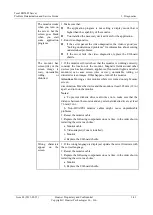
3 Diagnostics
Tecal RH5485 Server
Problem Determination and Service Guide
3-38
Huawei Proprietary and Confidential
Copyright © Huawei Technologies Co., Ltd.
Issue 02 (2011-05-25)
3.5.8 Memory problems
Table 3-9
Memory problems
Follow the suggested actions in the order in which they are listed in the
Action column until the problem is solved.
See Chapter 4, “Parts listing, ” to determine which components are customer
replaceable units (CRU) and which components are field replaceable units
(FRU).
If an action step is preceded by “(Trained service technician only),” that step
must be performed only by a trained service technician.
Symptom
Action
The
amount
of
system
memory
that is displayed is
less
than
the
amount of installed
physical memory.
Note:
If you change the memory, you must update the memory
configuration in the Setup utility.
1. Make sure that:
No error LEDs are lit on the operator information panel, the
memory card, or on the MAX5 memory expansion module.
Memory mirroring does not account for the discrepancy.
Scalability does not account for the discrepancy.
Note:
Each node in a multi-node configuration uses 256 MB of system
memory.
In a two-node configuration, make sure that both nodes have
started and all the devices between the two nodes have been
counted.
The memory modules are seated correctly (see “Removing a
DIMM” and “Replacing a DIMM”).
You have installed the correct type of memory.
If you changed the memory, you updated the memory
configuration in the Setup utility.
All banks of memory are enabled. The server might have
automatically disabled a memory bank when it detected a problem,
or a memory bank might have been manually disabled.
2. Check the POST event log for error message 289. If a DIMM was
disabled, run the Setup utility and enable the DIMM. See Chapter 6,
“Configuration information and instructions,”.
3. Run memory diagnostics.
4. Make sure that there is no memory mismatch when the server is at the
minimum memory configuration (two 1 GB DIMMs).
5. Reinstall the removed DIMMs, one pair at a time, in the memory
cards and the MAX5, making sure that the DIMMs in each pair match.
6. Reinstall the removed memory cards one memory card at a time (see
“Removing a memory card” and “Replacing the memory card” ),
making sure that the DIMMs on each card match.
7. Reseat the following components:
a. DIMM






























